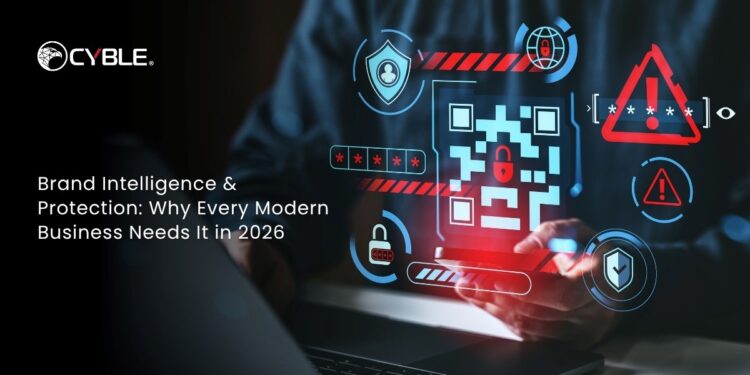In 2026, protecting your brand means safeguarding your digital identity, reputation, and customer trust from online threats — not just managing how your brand looks or sounds. Media headlines are filled with stories of fake domains, phishing campaigns, and social media impersonations that can damage a company’s reputation overnight. To prevent businesses from falling victim to such scams, cyber takedown services and Brand Intelligence & Protection have become essential. It’s a proactive strategy that not only secures a company’s digital identity but also strengthens customer trust and ensures business continuity.
Read on the full article to understand what Brand Intelligence & Protection is, how it works and why it matters in 2026.
What is Brand Intelligence & Protection?
To put it simply, brand intelligence and protection entail the constant monitoring, detection, and mitigation of threats that make the most of your brand’s online identity. It means spotting fake websites, unauthorized usage of trademarks, and dishonest activities like business email compromise (BEC) or phishing scams; these are the three main ones included in it.
Why Brand Intelligence & Protection Matters in 2026
A research report reveals that the Brand Protection Software Market was worth USD 3.21 billion in 2024 and is anticipated to reach USD 7.68 billion by 2033, thus having a CAGR of 12.00% for the period of 2026 to 2033. The steep incline is indicative of the increasing cognizance towards brand hazards and the need for preemptive defenses. Talk about brand intelligence and protection here are some more reasons why they will be important in 2026:
- Digital Identity Is a Target: Cybercriminals mislead consumers and steal data by creating fake domains, impersonating accounts, and cloning websites. The right Brand Intelligence & Protection makes it possible to find such impersonations and eradicate them before the trouble with trust has already begun.
- Brand Trust Equals Business Value: A phishing campaign once launched in the name of the company can cause significant reputation damage.
- Regulatory and Compliance Demands: Regulatory authorities and governments are becoming more and more strict, expecting organizations to take the responsibility for digital crimes associated with their brands. Well-structured Brand Intelligence & Protection systems keep the organizations in line with the requirements of data protection and anti-fraud legislation.
- Growing Digital Footprints: The increasing digital ecosystems and global e-commerce has put even small and mid-sized businesses into the spotlight on multiple platforms. The larger the digital footprint, the more the need for monitoring and capacity to take down unauthorized activities in real-time becomes essential.
Key Market Trends Driving Growth
The following are some of the biggest factors moving forward include:
- More Efficient Use of AI and Machine Learning: Artificial intelligence or AI is at the center of brand protection today. It detects fake websites, duplicate social accounts, and phishing links in seconds. With the ability to see suspicious patterns early, AI enables companies to triage before problems develop or worsen.
- Need for Protection Across All Channels: Today, businesses engage with customers with multiple interaction points, from email and social media to web stores and mobile apps. This is driving demand for consistent monitoring across the touchpoints. Multi-channel vertical protection ensures that where a brand is present online and misuse occurs, it is identified and contained before it worsens.
- Greater Focus on Compliance and Regulations: With tighter global data flow and consumer protection, organizations are under significantly higher expectations to take ownership and move quickly when they see misuse of their brand. Today, Modern Brand Intelligence & Protection tools make this easier with automated compliance checks and reporting, facilitating faster response for a better outcome.
- Growing Digital Footprints: The digital ecosystem is growing, and global e-commerce is expanding, even small and medium businesses have a digital presence that spans several platforms. The bigger your digital footprint, the more important it is to be able to monitor and take down in real-time.
- Rising Consumer Awareness: Customers are more alert than ever about online scams. They prefer brands that show transparency and take visible steps to stop impersonations. Businesses that act quickly — such as initiating public takedowns or issuing alerts — are finding it easier to earn and maintain customer trust.
Challenges in Brand Protection
Even though Brand Intelligence & Protection plays a vital role in keeping businesses secure, it comes with its own set of challenges. These Brand Intelligence & Protection challenges can affect how efficiently a brand protection strategy works if not addressed properly. Here some of the challenges:
- Difficulty in Detecting Brand Misuse: Spotting brand impersonation across the vast digital landscape — including the dark web, social platforms, and online marketplaces — is no easy task. It requires advanced monitoring tools, global visibility, and constant vigilance to uncover misuse before it spreads.
- High Setup and Maintenance Costs: Setting up strong protection systems and building rapid response workflows can be expensive, especially for smaller companies. Yet, when weighed against potential reputational and financial losses, the investment in protection often proves worthwhile.
- Striking the Right Balance Between Security and Privacy: Continuous monitoring of online spaces must comply with privacy laws and data regulations. Ensuring protection without crossing ethical or legal boundaries is a delicate but essential balance for organizations to maintain.
- Shortage of Skilled Cyber Professionals:
Effective Brand Intelligence & Protection depends on experts who can analyze complex data, prioritize threats, and act quickly. Unfortunately, the ongoing global shortage of cybersecurity talent makes it challenging for many organizations to build dedicated brand protection teams.
Cyble specializes in proactive digital defense, empowering organizations to stop impersonation and mitigate it through rapid takedowns. Its Brand Intelligence & Protection capabilities enable companies to neutralize business email compromise, address phishing attacks, and launch cyber takedown services enriched with contextual intelligence.
By combining AI-driven detection, real-time threat monitoring, and advanced Incident Management Solutions, Cyble helps businesses preserve their brand integrity and reputation. While not overly promotional, it’s worth noting that these capabilities align with Cyble’s broader commitment to building resilient digital ecosystems supported by Attack Surface Management Services and Threat Intelligence Solutions.
How Brand Intelligence & Protection Functions:
- Detecting Impersonation: Automated crawlers and artificial intelligence algorithms crawl domains, social media platforms and app stores to search for impersonation accounts and impersonation listing.
- Verify and Assess Risk: Threats that are discovered undergo verification for credibility and impact, ensuring that you focus on the most harmful impersonations to your brand
- Timely Takedown: When threats are verified, the system generates a cyber takedown services request to have the malicious content removed without delays from public access.
- Incident Management and Recovery: The Incident Management Solutions integration ensures that all brand threats that require investigation are located, escalated, and closed.
- Continuous Monitoring and Intelligence: With continuous scanning and artificial intelligence with learned analytics, the brand can remain vigilant of new threats to their brand identity.
Conclusion
The future of Brand Intelligence & Protection lies in deeper automation and predictive analytics. In the next decade, AI-driven monitoring, blockchain-based authenticity verification, and autonomous cyber takedown services will become standard across industries.
Businesses integrating ASM and threat intelligence data into brand protection strategies will have a decisive advantage in identifying and neutralizing threats before they escalate.













